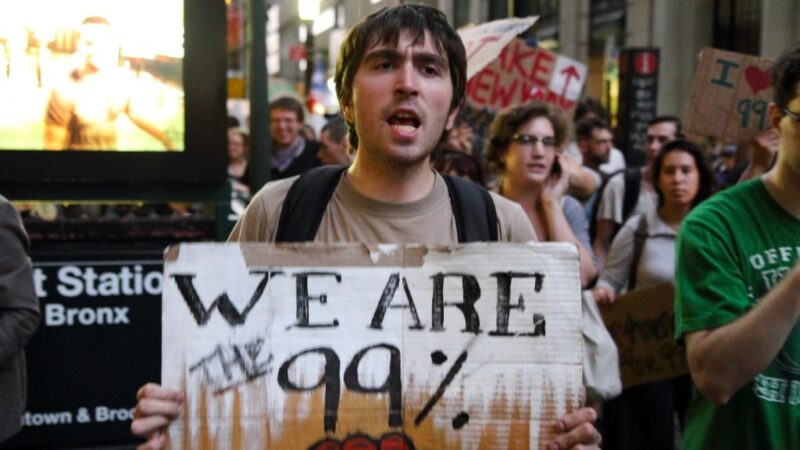 "Equal Justice Under Law": The U.S. Supreme Court. Does a just society need more than equality under law?
"Equal Justice Under Law": The U.S. Supreme Court. Does a just society need more than equality under law? The title question I was asked, “How much state does a just society need?” assumes that a just society requires a superior power—the state. The question is about “how much state” is needed for a society to be just. To be able to answer it, we must first ask what is meant by the justice for which the state is necessary. For justice is, after all, a virtue of the human individual. The state does not really seem to play a role here. Obviously, there is something about the title question that addresses another issue, namely justice as a condition or state of affairs of society as a whole. The question then arises as to what role the government must play to create such a state or to guarantee its preservation.
The Socially Just Society – The Ideal and the Reality
When we think of expressions like “justice” or “just society,” we automatically think of the fair distribution of wealth, income, opportunities, and resources; we imagine a certain “pattern” of society or at least believe that a just society is a society based on solidarity, in which the politically organized community— and that means the state—ensures that no one is left behind, that everyone’s basic needs are met, and that the basic demands for health, education, and social welfare are also met.
Such a society is certainly a desirable ideal. Many persons form their concepts of justice and injustice based on this ideal. They argue that in order to achieve such “social justice,” the state must intervene in the normal course of economic processes and their outcomes by redistributing income, and ideally assets, in such a way that the lowest income strata would receive an increase in income through transfers, and the highest strata receive a corresponding decrease in income. By putting some people in a better position at the expense of others, social differences perceived as unfair can be balanced out, and equal opportunities can be created for all.
However, this ideal is very much clouded by a more complicated and far less perfect reality. For example, in the run-up of recent protests by the French “yellow vests,” we heard that the income of the lowest 20 percent in France increases by 72 percent through government transfer payments—at the expense of their better-off fellow citizens.[1] Who are these more wealthy citizens? In addition to the top earners, it is primarily the members of the lower middle class who must hand over more than half of their relatively modest income to the state—hardly receiving any additional benefits themselves. They were the first to take to the streets because of the increase in fuel taxes.
At issue is not the welfare state as such, with its social security systems based on the insurance principle. At issue, rather, is the state that redistributes wealth and equalizes income for social purposes, weakening the lower segments of the middle class most of all, perpetuating the poverty of the poorest by making them dependent on state benefits, and over the decades repeatedly creating new poverty—but primarily unemployment, especially hidden unemployment. This was proven long ago to be the case for the U.S. through the empirical work of sociologists like Charles Murray,[2] but it is also a general pattern in modern social and welfare states.[3] Well-intentioned social policy leads to the weakening of the middle class. The blame is wrongly placed on the highest earners and their increasing distance from the lower classes. This despite the fact that, at least in the U.S., it is precisely the top one percent that is responsible for the great innovations of recent times and thus also for the prosperity gains of broad sections of the population.[4]
The often extremely high taxation of the super-rich, but also of capital and corporate profits, does not mean an immediate loss of quality of life for top earners; however, it does impede the growth potential of economies, and it thus impedes more and more productive work opportunities and higher real wages. As paradoxical as it sounds: in a capitalist economic system, the extremely high taxation of the super-rich works against the public good. Innovation, growth, and real wage increases require the accumulation of capital, and this inevitably means that phases of greater innovation and the resulting general rise in living standards are characterized by increased social inequality. Without the super-rich and corresponding inequality there is no mass prosperity—which does not mean that growth always goes hand in hand with an increase in inequality; sometimes the opposite is the case. In the U.S., for example (but also in Europe after the Second World War), as growth and prosperity increased, inequality decreased. Despite cyclical increases in inequality during periods of accelerated innovation—as is the case today because of the close link between digitalization and globalization—healthy growth seems more likely to reduce inequality in the long run.[5] The connection between innovation, growth, and inequality is based on inescapable economic laws, which are confirmed by the history of the last two hundred years. A meaningful and realistic debate about justice is therefore impossible without taking such economic interrelationships into account. It would devolve into a moralism that is out of touch with reality.[6]
The Problem Is Not Inequality, but Poverty
Recently, an OECD study from 2014 has repeatedly been cited, which according to media reports is supposed to prove that social inequality, i.e. the increasing gap between the wealthiest, especially the top ten percent (or even the top tenth of a percent) and the rest of society, has a negative impact on economic growth.[7] In reality, however, the OECD study says the exact opposite: “…no evidence is found that those with high incomes pulling away from the rest of the population harms growth.” The problem is rather the gap between the lowest income groups and the rest of the population (“what matters most is the gap between low-income households and the rest of the population”). It is this kind of inequality, the study says, that has a negative impact on growth.[8]
This is, strictly speaking, a trivial result. It is obvious: the more low-income and poorly educated people there are in a society, the lower the growth rate must be compared to societies with fewer low-income earners and better educated people. It is not inequality as such that hinders growth. Rather the fact that this lowest section of the population lives at the expense of the rest of the population, is itself unproductive; moreover, there are few incentives for such people to work productively, and they are unable to do so because of a lack of qualifications. In short, the reason why societies with great inequality as regards the lowest income groups are weaker in terms of growth is not the wealth of the rich, but the poverty and the educational inequality of the low-income groups. Their condition is caused or perpetuated precisely by socially motivated regulation of the labor market and other obstacles to job creation—such as high tax progression, high capital and corporate taxes, and other burdens on companies and employers.[9]
The initial intuitions about a just society made possible by state intervention thus seem to lead us on the wrong track. The justice of a society has nothing to do with the distribution of income and wealth, or with the level of social inequality. “From a moral perspective, it is not important that everyone has the same amount. What matters morally is that everyone has enough.”[10] The justice of a society is determined by the question of whether it is ordered in such a way that no one lives at the expense of others; in other words: that the rich are not rich at the expense of the less rich, and the low-income earners are not better off at the expense of higher earners, or even made dependent on them. A just society should enable everyone to live in dignity and freedom. However, a life in dignity and freedom does not depend so much on material resources, and certainly not on the equality of material resources, but on whether one stands on one’s own feet in life, i.e. that one does not live at the expense of others, and thus has “enough”—even if one has little compared to others. The question of justice is decided by the space for individual freedom and self-responsibility and by the possibilities available in a society to earn a sufficient share for an independent and self-determined life through one’s own work—not by who owns how much or even by the extent of inequality, and even less by the extent to which social inequality is reduced by political measures, e.g. by redistribution.
Unfortunately, the question of a just society today is not usually posed in this way, but in a purely materialistic way, ultimately aiming at the justification of redistribution, because inequality—as a “negative yardstick,” so to speak—serves as an argument that has taken up highly emotional and clear thinking, becoming confused and correspondingly emotionally charged. But Catholic Social Teaching is based on another tradition. It saw the question of justice not as a question of distribution (of income and property), but as one of justice, of equality of rights and, very importantly, of freedom from state paternalism and dependence: a freedom that enables the individual and the smallest communities, especially the family, to provide for themselves. Let me first illustrate this by looking back into the past at the concept of distributive justice and its transformation into ‘distributional justice’,[11] so that we may examine the essential questions.
This article is an excerpt from the text of a lecture given by the author at the 6th International Goch Talks: “The Market versus Morality?” on January 12-13, 2019, organized by the Arnold Janssen Solidarity Foundation at the Collegium Augustinianum Gaesdonck in Goch, Germany. It will be published in a conference volume together with the other conference contributions.
Here you can download the whole text as PDF: Austrian Institute Paper No. 24
[1] Cf. Nina Belz, “Woher kommt die Wut der gelben Westen? Das französische Steuersystem sorgt zwar für eine gerechtere Einkommensverteilung—allerdings zu einem hohen Preis,” Neue Zürcher Zeitung (December 14, 2018); The source for the figures is the Institut national de la statistique et des études économiques / INSEE. This document can be found directly on the INSEE website or through the Google search engine, and it has the following file name: FPORSOC18m4_F4.4.pdf.
[2] Charles Murray, Losing Ground: American Social Policy 1950-1980 (New York: Basic Books, 1984) Second edition, 2015.
[3] Cf. James Bartholomew, The Welfare of Nations (London: Biteback Publishing, 2015).
[4] Cf. Edward Conard, The Upside of Inequality. How Good Intentions Undermine the Middle Class (New York: Portfolio, 2016).
[5] Cf. Branko Milanović, Die ungleiche Welt. Migration, das Eine Prozent und die Zukunft der Mittelschicht (Berlin: Suhrkamp Verlag AG, 2016), esp. 98ff.
[6] It should also be taken into account that the policy of cheap money (low to zero interest rates) that has been deliberately pursued for almost two decades has led to a huge increase in asset prices (real estate and shares), which on paper has made the rich even richer—a bubble that will burst.
[7] Federico Cingano, “Trends in Income Inequality and its Impact on Economic Growth,” OECD Social, Employment and Migration Working Papers, No. 163, (OECD Publishing: 2014), http://dx.doi.org/10.1787/5jxrjncwxv6j-en.
[8] Ibid., 6.
[9] The harmful effects of minimum wages for the least qualified must also be taken into account; see, in addition the unambiguous study of David Neumark and William L. Wascher, which critically evaluates other studies on the issue: Minimum Wages (Cambridge, MA: MIT Press, 2008).
[10] Harry G. Frankfurt, Ungleichheit. Warum nicht alle gleich viel haben müssen (Berlin: Suhrkamp, 2016), 17.
[11] Translator’s note: The German word translated as ‘distributional justice’ is Verteilungsgerechtigkeit, which has become a common word in German and is used instead of the more technical term for ‘distributive justice’ (“distributive Gerechtigkeit”). The problem that the author is pointing out is that what is translated as ‘distributional justice’, for lack of a proper English equivalent, is often not properly distinguished from distributive justice as it was traditionally understood.



